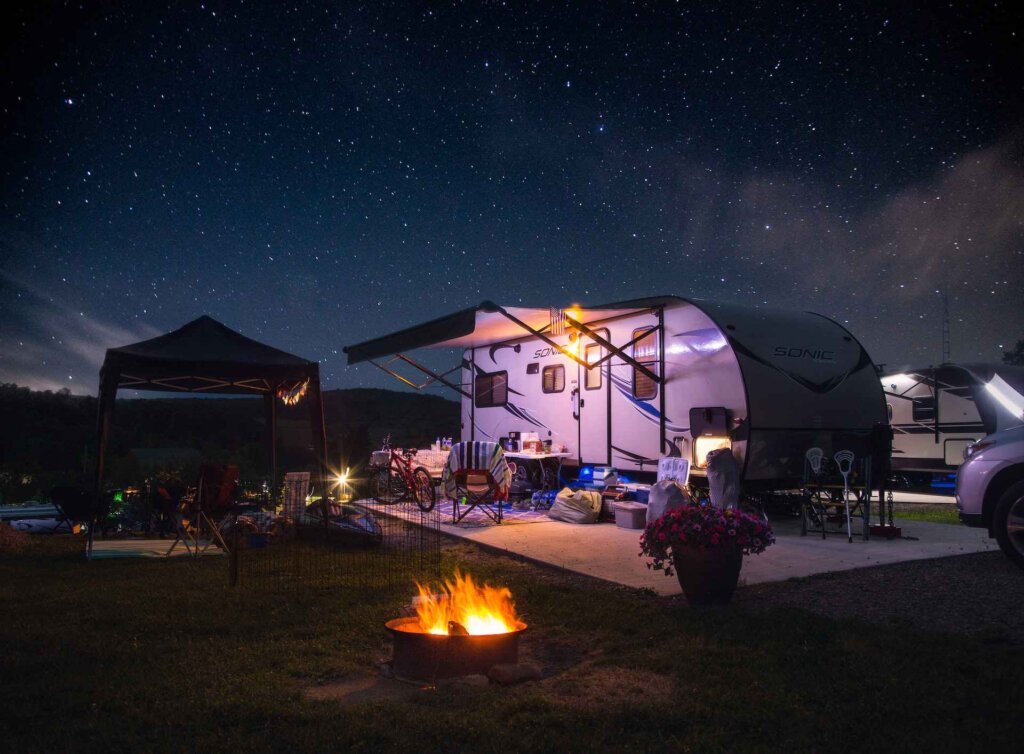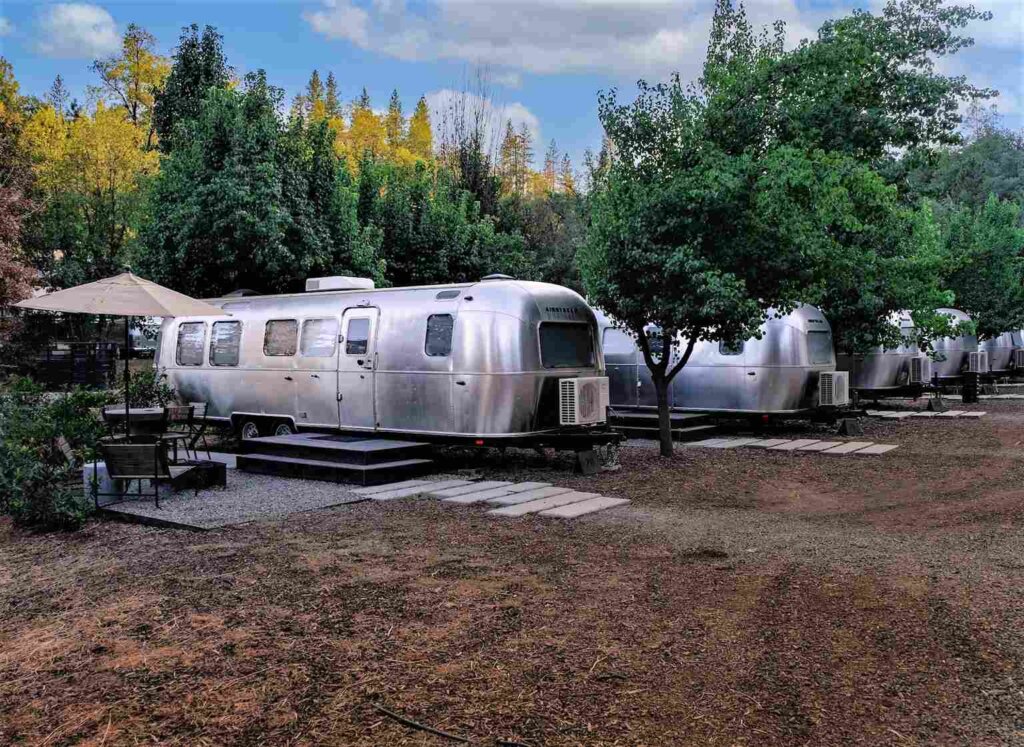Nowadays I am at ease while backing up a trailer. Some of that comfort comes from practice, and some with the confidence that comes with age and experience. But I still vividly remember the fear that accompanied towing a trailer for the first time. Between proper hitch-up methods, avoiding dangerous trailer sway, and safe backup practices, there’s an abundance of knowledge and many important techniques to learn so you can safely and confidently travel with a camper trailer.
Issues Faced by Newbie Trailer Owners
The first couple of times a newbie tries to back up a trailer they will likely encounter some of the following issues:
- Overcorrecting: While reversing, it can seem like even the smallest movement of the steering wheel will throw the trajectory of the trailer completely out of whack. This is a result of overcorrecting and the exaggerated use of the tow vehicle’s steering wheel. Backing up a trailer requires the employment of controlled and intentional adjustments of the steering wheel.
- Visibility: RVs are big and bulky; pretty much one big blind spot. This can take a while to get used to, especially if the majority of driving done by the RV owner has been in vehicles with large windows and close to zero blind spots like sedans and SUVs. The sudden lack of ability to use a rearview mirror and decreased efficiency of side-mirrors can be panic-inducing.
- Jackknifing: Great efforts should be made to avoid this situation while towing a trailer. Jackknifing occurs when a trailer and its tow vehicle end up folded together at an acute angle. These types of incidents usually result in damage to both the tow vehicle and the trailer and are often a result of uncontrolled trailer sway, or improper reversing.

Learning How to Back Up a Travel Trailer
Getting some experience in towing and backing up your travel trailer before traveling with it is the number one preventative measure you can take to avoid a trailer mishap while camping. In fact, I’ll go as far as to say that it would be extremely foolish to take a camper trailer on an adventure without any practice driving while hitched up.
Lucky for new trailer owners, more than a few resources exist to help folks learn how to safely haul a rig.
Classes
Both in-person and online classes are available for enrollment for those of you who benefit from curriculum-based instruction.
In-Person Instruction
In-person classes offer the most comprehensive instruction on how to drive and back up a trailer. Most in-person RV schools train their students in the student’s personal car, towing their own RV. This is extremely beneficial to the learning process as it allows you to receive personalized instruction on how to drive the primary rig you will be towing. It’s similar to the concept of learning how to drive a manual transmission car in the same car you will be driving most because every clutch has a unique feel.
Similarly, every car/trailer combination has a unique driving feel. By learning in your own car and trailer, you set yourself up to be intimately familiar with how your rig drives by the end of the course. In-person drive schools charge a moderate tuition fee, ranging from $300-$1500. Short group classes will be on the lower end of that cost range, while private, all-day lessons cost more.
A potential hurdle in attending an RV driving course will be actually finding a school that is close to where you live. While I imagine most US states have at least one RV driving school, you may have to commit to a long drive to attend.
Online Instruction
For those of you who don’t have the time and resources for in-person training, or who simply prefer online instruction, there are a number of online RV driving courses available for purchase. Online RV driving courses are significantly cheaper than in-person courses and generally considered to be more convenient to the student as they can be completed at the student’s own pace.

A fantastic perk of joining an online driving school is that many online courses allow you permanent access to course materials such as PDFs and instructional videos. This comes in handy if you end up wanting or needing to reference those materials later, let’s say for example, when you are in a tight spot while backing up your trailer.
Simulation Games
While this initially might seem like a silly suggestion, realistic driving simulators can give users a very accurate feel for what it might be like to drive a big rig such as an RV or a semi-truck. Simulators are used for training purposes in the aviation industry, by railway companies, and by long-haul truckers.
If you have never driven a big rig of any sort, are terrified to try, but are determined to learn, a trailer simulator might be the perfect first step in your journey to towing trailers. A simulator offers a perfect, low consequence opportunity to get the feel for towing a trailer. With a couple of hours on the simulator under your belt, you should be able to muster the confidence to get behind the wheel of your own rig.
Practice
Practice makes perfect, right?
I can guarantee that the most surefire way to gain confidence and skill at backing up a trailer is going to be simply practicing. No amount of book learning, instruction, or simulation can beat time behind the wheel.
To go about practicing, you’ll want to find a very large, empty parking lot that offers plenty of open space and maneuverability. Schools and churches are great places to look because their parking lots are generally empty in the evenings. Using traffic cones, scrap wood, or anything that you are OK with potentially being driven over, set up a practice course that mimics the dimensions and layout of an RV park.
Once your course is set up, hop behind the wheel of your tow vehicle and practice backing into the “parking space” you created for your rig. Don’t get bummed if you’re pretty bad initially, just keep at it and things will begin to click. Practice backing into the spot from the driver’s side and passenger side, so you gain confidence in both directions.
If possible, have a friend or family member accompany you and act as your spotter. The job of a spotter is to stand behind a rig as it is reversing and instruct the driver on how to position the rear of the trailer. The spotter also watches for potential collisions and warns the driver if they are about to hit something.
Tips for Parking a Trailer

Practice and experience will take you most of the way to becoming a master at backing a trailer into a parking spot. The following tips and tricks will take you the rest of the way.
Use Your Mirrors
There’s no need to put a crick in your neck while backing up a trailer. Too many times I’ve seen people whipping their head back and forth while they back up a trailer in order to watch what the trailer is doing. There is no need to do this. Using the side mirrors on your tow vehicle should be enough to monitor what the trailer is doing and make necessary adjustments to trajectory.
If your side mirrors don’t provide a clear enough view of your trailer, consider purchasing side mirror extensions. These aftermarket parts strap onto the body of a vehicle’s side mirror and provide an extra two inches of mirror. This increases visibility of the rear of a trailer and decreases blind spots.
Install a Backup Camera
Many modern vehicles are being sold stock with backup cameras. Located on the rear of a vehicle, these cameras allow drivers to see what is directly behind their car as they reverse. While the initial intention behind backup cameras was mostly related to safety, they have proven exceptionally useful in aiding the hitching up process. Travel trailer owners that have backup cameras love the ability to see exactly where their tow vehicle’s ball is in relation to the tongue of their trailer.
Some RVers have even taken to installing backup cameras on the rear of their trailers so they can see exactly what the tail of their rig is doing. I suggest buying and installing a backup camera for your travel trailer if you consistently struggle to park your camper or plan to go on solo adventures in your trailer.
Rely on Your Spotter
A good spotter is worth their weight in gold when backing up a trailer. Parking-related collisions and damage is entirely avoidable when a driver and their spotter have solid communication and an established system.
Before camping, have a talk with your spotter and determine what your system will be. Whether it is hand signals, communicating over hand-held radios, or simply hollering out directions, make sure you and your spotter know what your system is, and what each command or hand signal will mean.
Steer From the Bottom

The best tip I have ever learned for backing up a trailer is to steer from the bottom of the steering wheel. Steering from the bottom allows you to turn the steering wheel the same direction that you want the trailer to go. This makes the whole process of backing up a trailer much easier and more intuitive.
So next time you go to park your rig, plant your hand on the bottom of the steering wheel and resist the urge to move it to the top.
Frequently Asked Questions
Check out these questions our readers have about backing up trailers.
Why is backing up a trailer so hard?
This comes down to the fact the reversing a trailer just isn’t super intuitive and confuses the mind of the inexperienced. Over time it will begin to feel more natural and eventually you will be reversing using only instinct and muscle memory.
I’ve owned a trailer for years and still suck at backing up, what should I do?
Practice, practice, practice! That’s the only way to get better at backing up a trailer. But eventually you might want to consider removing the stress of backing up entirely by trading your trailer in for a motorhome.
Travel trailers are awesome toys to have for escaping the stresses of this modern world and experiencing the majesty of the outdoors. I would hate to see anyone deprive themself the joys of trailer adventures because of a fear of backing into a campsite or parking space.
With patience, persistence, and determination, absolutely anyone can learn how to drive and reverse a trailer. So don’t be afraid! Just go do it!
Happy camping!



